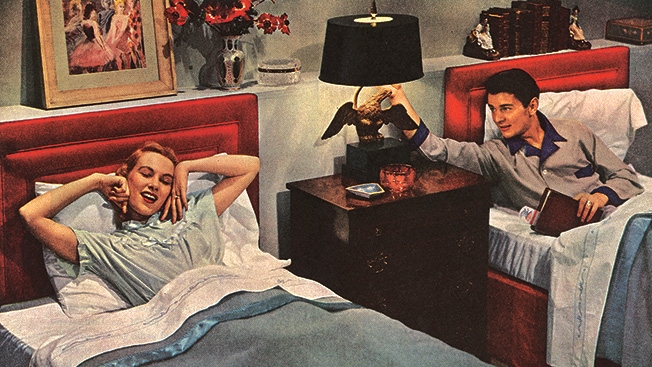
The fact is largely forgotten, but first lady Eleanor Roosevelt used to host a weekly radio show sponsored by the Simmons mattress company—a cultural footnote immortalized by Cole Porter in one of the last stanzas of “Anything Goes”: “So Missus R. with all her trimmin’s, can broadcast a bed from Simmons ’cause Franklin knows, anything goes.” Porter’s line was also a sly reference to the fact that while Mrs. Roosevelt might have slept in her Simmons, her presidential husband was said to be fond of, er, more mattresses than just his own.
The line is also worth mentioning here because, in those days when it came to mattress advertising, anything didn’t go.
Adhering to the media decency standards of the era, mattress print advertising kept its imagery exceedingly prim and proper. Obviously, those days are long gone. But the painful prudishness of this 1949 Simmons ad—contrasted with the wide-open frankness of its 2013 Sleep Number counterpart—affirms a familiar truism: A brand can be sold just fine on its own merits but adding sex sure ain’t a bad idea.
If your only plans are to use a mattress for sleeping, the pitches in both of these ads actually haven’t changed that much. “What connects them is that both lean on technology,” observed Peter Madden, president and CEO of marketing agency AgileCat. “The Simmons ad has the stamp of the U.S. Testing Company, complete with the guy in the white lab coat. The Sleep Number mattress shows the control module sitting right there. So both of these ads embrace technology.”
Both, however, do not embrace sexuality, the unavoidable subtext for a product like mattresses. While couples have been sharing beds since the late 1800s when the industrial revolution forced people to live in smaller city dwellings, ads didn’t reflect that reality when postwar, suburban ideals of wholesomeness were a surer road to profits. Though this darling couple might be young newlyweds (the rings are clearly visible), “They’re buttoned up and there’s nothing going on here tonight, folks,” Madden said, adding, “This ad would never have been in Ladies’ Home Journal without that dresser between the beds—it was too risqué.”
It would take some daring on the part of TV shows including Mary Kay and Johnny, The Adventures of Ozzie and Harriet and, oddly enough, The Flintstones and The Munsters—all of which portrayed couples sharing a bed—to loosen the cultural buttons. By the late 1960s, most mattress ads had followed suit.
And a good thing, too. As the Sleep Number ad shows, even the suggestion of sexuality adds a potent ingredient to the marketing formula. Sleep Number’s technical feats aside, “There’s a hot-looking couple, she’s wearing his shirt and his shirt is off—so there’s already something happening here,” Madden said. “The bed itself is in a suggestive pose. So it’s a not-so-subtle invite that you might enjoy this mattress to a greater degree than just sleeping in it.”
Hey, anything goes.





